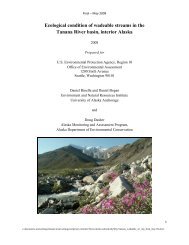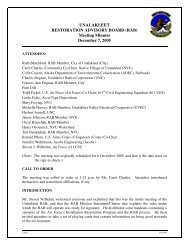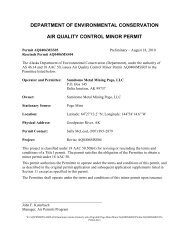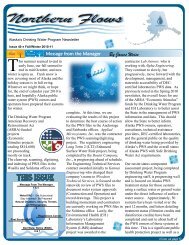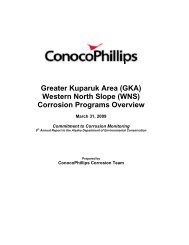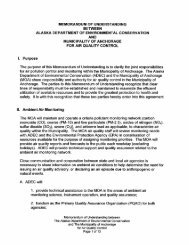2012 Ocean Ranger Guidebook Revision 3-7-12 - Alaska ...
2012 Ocean Ranger Guidebook Revision 3-7-12 - Alaska ...
2012 Ocean Ranger Guidebook Revision 3-7-12 - Alaska ...
Create successful ePaper yourself
Turn your PDF publications into a flip-book with our unique Google optimized e-Paper software.
<strong>20<strong>12</strong></strong> <strong>Ocean</strong> <strong>Ranger</strong> <strong>Guidebook</strong> 3-7-<strong>12</strong><br />
Job Aid Item: 2.2.h<br />
Text: Check there are no plastics or synthetics discharged overboard. 33 CFR 151.67<br />
Background: Discharge of plastics is not allowed in any waters. Plastic items are often difficult to break<br />
down naturally and can impact wildlife. Garbage sorting crews often check the garbage for disposal of<br />
plastics. This includes plastic bottles, caps, wrappings, blister cards, and other plastics. Most vessels<br />
separate the garbage from plastics by using dedicated garbage cans; however plastic still may end up in<br />
the garbage stream.<br />
Most garbage is sorted in dedicated spaces. Engine room or construction wastes can be handled<br />
separately. These wastes are also subject to the plastic prohibition. This includes ropes with synthetic<br />
materials, carpets, packaging, and canisters.<br />
What to check for: Check that wastes are sorted and plastics are removed if wastes are disposed of<br />
overboard.<br />
Citations:<br />
33 CFR 151.67 Operating requirements: Discharge of plastic prohibited.<br />
No person on board any ship may discharge into the sea, or into the navigable waters of the United States, plastic or garbage mixed with<br />
plastic, including, but not limited to, synthetic ropes, synthetic fishing nets, and plastic garbage bags. All garbage containing plastics requiring<br />
disposal must be discharged ashore or incinerated.<br />
[CGD 88–002, 54 FR 18405, Apr. 28, 1989, as amended by CGD 88–002A, 55 FR 18583, May 2, 1990]<br />
Definition of Plastics from 33 CFR 151: Plastic means any garbage that is solid material that contains as<br />
an essential ingredient one or more synthetic organic high polymers, and that is formed or shaped<br />
either during the manufacture of the polymer or polymers or during fabrication into a finished product<br />
by heat or pressure or both. “Degradable” plastics, which are composed of combinations of degradable<br />
starches and are either (a) synthetically produced or (b) naturally produced but harvested and adapted<br />
for use, are plastics under this part. Naturally produced plastics such as crabshells and other types of<br />
shells, which appear normally in the marine environment, are not plastics under this part.<br />
Note: Plastics possess material properties ranging from hard and brittle to soft and elastic. Plastics are used for a variety of<br />
marine applications including, but not limited to: food wrappings, products for personal hygiene, packaging (vaporproof<br />
barriers, bottles, containers, and liners), ship construction (fiberglass and laminated structures, siding, piping insulation,<br />
flooring, carpets, fabrics, adhesives, and electrical and electronic components), disposable eating-utensils and cups (including<br />
styrene products), bags, sheeting, floats, synthetic fishing nets, monofilament fishing line, strapping bands, hardhats, and<br />
synthetic ropes and lines.<br />
Job Aid Item: 2.2.i<br />
Text: Incinerator ashes, if discharged overboard, are free of plastic residue (clinkers) or free of<br />
unburned food wastes if landed ashore IAW 33 CFR 151.67<br />
Background: Incinerator ash could include unburned items. Plastics can melt into larger pieces rather<br />
than combusting. Food waste can also be present due to the high water content. Not all vessels<br />
incinerate plastics, some choose to offload or recycle these.<br />
Operators should have procedures for dealing with incinerator ash. Useful items to know is how it is<br />
removed from the incinerator, how volumes(or weight) are obtained, how incinerator ash is categorized<br />
as waste, and what waste streams are incinerated.<br />
107






